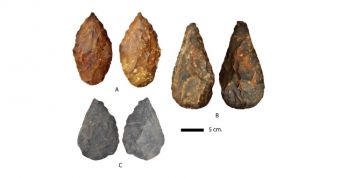A paper published in the journal PLOS ONE this past July 24 announces the discovery of tens of thousands of artifacts dating back to the Early Stone Age in South Africa.
Archaeologists with the University of Toronto in Canada detail that, based on the condition in which they were found and their appearance, the artifacts must be somewhere between 700,000 and 1 million years old.
As detailed in a press release concerning this archaeological find, the Early Stone Age artifacts were discovered while exploring a site close to the town of Kathu in South Africa's Northern Cape province.
Due to the fact that this area has until now produced tens of thousands of hand axes and other tools left behind by our ancestors, archaeologists argue that the site is one of the richest to have until now been documented in South Africa.
Writing in the journal PLOS ONE, University of Toronto specialists and fellow researchers explain that the site where these artifacts were found is part and parcel of a region of exceptional importance. This region is dubbed the Kathu complex.
Apart from the tens of thousands of artifacts whose discovery was announced just yesterday, the Kathu complex has until now coughed out fossilized remains of ancient elephants and hippos, together with spear-like tools dating back to at least 500,000 years ago.
Hence, archaeologists and historians say that, all things considered, humans must have been a fairly common sight in this part of South Africa thousands of years ago. This means that the region itself must have been more welcoming than it now is.
“We need to imagine a landscape around Kathu that supported large populations of human ancestors, as well as large animals like hippos. All indications suggest that Kathu was much wetter, maybe more like the Okavango than the Kalahari,” says researcher Michael Chazan.
The bad news is that this complex of archaeological sites in South Africa's Northern Cape province is in danger of being destroyed as a result of mining activities in its proximity and even within its perimeter. Researchers and developers are now trying to figure out how to best protect it.
“The site is amazing and it is threatened. We’ve been working well with developers as well as the South African Heritage Resources Agency to preserve it, but the town of Kathu is rapidly expanding around the site,” says study lead author Steven James Walker.
“There is no question that the Kathu Complex presents unique opportunities to investigate the evolution of human ancestors in Southern Africa,” Michael Chazan, the current director of the Archaeology Centre at the University of Toronto, explains the need to safeguard this archaeological site.

 14 DAY TRIAL //
14 DAY TRIAL //